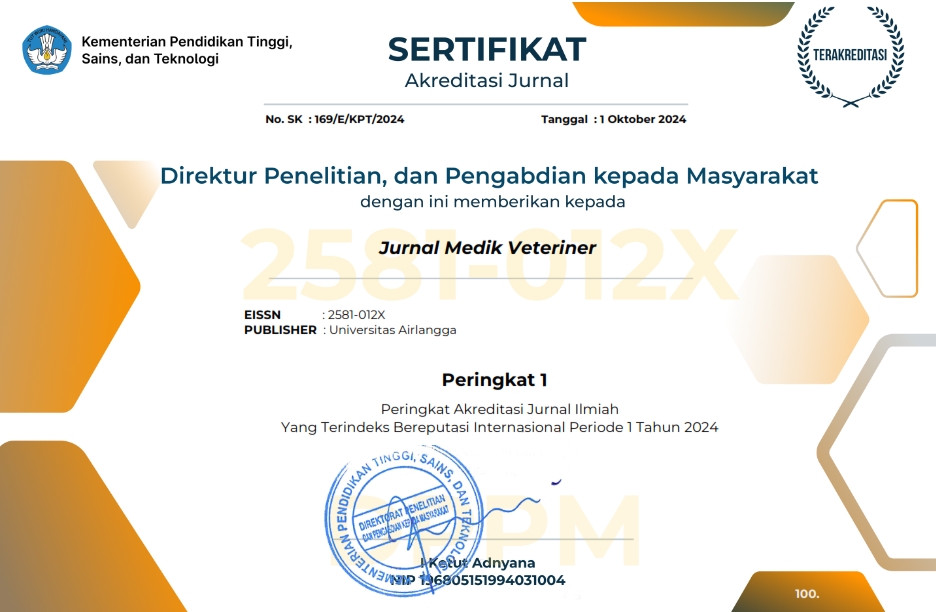Vibriocidal Activity of Ethanol Extract of Moringa Leaves and Its Effect on the Growth of Pacific White Shrimp

Downloads
This study aimed to evaluate the vibriocidal potency of Moringa leaf ethanol extract (MLEE) and assess the effectiveness of dietary supplementation of MLEE on Pacific white shrimp growth performance. A vibriocidal activity was performed using disk diffusion and tube dilution methods. The results showed Vibrio parahaemolyticus was more susceptible than Vibrio harveyii with an inhibitory zone of 11.30 to 22.90 mm. The minimum inhibitory concentration (MIC) of MLEE against V. parahaemolyticus was recorded at 12.5%, similar to V. harveyii. The effectiveness of MLEE on diet was monitored by the growth of the shrimps for 40 days of culture. Shrimps with an average initial weight of 2.50±0.05 g were acclimatized in 10 days. The MLEE was administered to the shrimps at different concentrations i.e., 10%, 15%, 20%, and 25%. The control diet was prepared without MLEE supplementation. After 40 days of culture, the shrimps fed with 10% of MLEE had the best growth. This study reported that MLEE potentially become vibriocidal agents. However, the administration on shrimp had no beneficial effect on its growth performance.
Adams, A., Aoki, T., Berthe, F. C. J., Grisez, L., & Kasunasagar, I. (2008). Recent technological advancements on aquatic animal health and their contributions toward reducing disease risks - A review. Manila, Philippines, pp: 71–88.
Aja, P. M., Nwachukwu, N., Ibiam, U. A., Igwenyi, I. O., Offor, C. E., & Orji, U. O. (2014). Chemical constituents of Moringa oleifera leaves and seeds from Abakaliki, Nigeria. American Journal of Phytomedicine and Clinical Therapeutics, 2(3), 310–321.
Awad, E., & Awaad, A. (2017). Role of medicinal plants on growth performance and immune status in fish. Fish and Shellfish Immunology, 67, 40–54.
Chakraborty, S. B., & Hancz, C. (2011). Application of phytochemicals as immunostimulant, antipathogenic and antistress agents in finfish culture. Reviews in Aquaculture, 3(3), 103–119.
Falowo, A. B., Mukumbo, F. E., Idamokoro, E. M., Lorenzo, J. M., Afolayan, A. J., & Muchenje, V. (2018). Multi-functional application of Moringa oleifera Lam. in nutrition and animal food products: A review. Food Research International, 106(October 2017), 317–334.
Ganatra, T. H., Joshi, U. H., Bhalodia, P. N., Desai, T. R., & Tirgar, P. R. (2012). A panoramic view on pharmacognostic, pharmacological, nutritional, therapeutic and phrophylactic values of Moringa oleifera Lam. International Research Journal of Pharmacy, 3(6), 1–7.
Genovese, G., Faggio, C., Gugliandolo, C., Torre, A., Spanò, A., Morabito, M., & Maugeri, T. L. (2012). Invitro evaluation of antibacterial activity of Asparagopsis taxiformis from the Straits of Messina against pathogens relevant in aquaculture. Marine Environmental Research, 73, 1–6.
Gilani, G. S., Xiao, C. W., & Cockell, K. A. (2012). Impact of antinutritional factors in food proteins on the digestibility of protein and the bioavailability of amino acids and on protein quality. British Journal of Nutrition, 108, S315–S332.
Gopan, A., Lalappan, S., Varghese, T., Kumar Maiti, M., & Peter, R. M. (2020). Anti-Nutritional Factors in Plant-Based Aquafeed Ingredients: Effects on Fish and Amelioration Strategies. Bioscience Biotechnology Research Communication, 13(12), 01–09.
Gupta, S., Jain, R., Kachhwaha, S., & Kothari, S. L. (2018). Nutritional and medicinal applications of Moringa oleifera Lam.”Review of current status and future possibilities. Journal of Herbal Medicine, 11(March 2017), 1–11.
Hajra, A., Mazumder, A., Verma, A., Prasad Ganguly, D., Mohanty, B. P., & Sharma, A. P. (2013). Antinutritional Factors in Plant Origin Fish Feed Ingredients: the Problems and Probable Remedies. Advances in Fish Research, V, 193–202.
Immanuel, G., Uma, R. P., Iyapparaj, P., Citarasu, T., Punitha Peter, S. M., Michael Babu, M., & Palavesam, A. (2009). Dietary medicinal plant extracts improve growth, immune activity and survival of tilapia oreochromis mossambicus. Journal of Fish Biology, 74(7), 1462–1475.
Jayanthi, M., Garg, S., Yadav, P., Bhatia, A., & Goel, A. (2015). Some newer marker phytoconstituents in methanolic extract of Moringa oleifera leaves and evaluation of its immunomodulatory and splenocytes proliferation potential in rats. Indian Journal of Pharmacology, 47(5), 518.
Kamble, M. T., Chavan, B. R., Gabriel, A., Azpeitia, T., Medhe, S. V, Jain, S., & Jadhav, R. R. (2014). Application of Moringa oleifera for development of sustainable and biosecure aquaculture. International Conference of Aquaculture Indonesia (ICAI-2014), 15(2), 64–73.
Kumar, V., Barman, D., Kumar, K., Kumar, V., Mandal, S. C., & De Clercq, E. (2012). Anti-nutritional factors in plant feedstuffs used in aquafeeds. World Aquaculture, 64–68.
Lotaka, R., & Piyatiratitivorakul, S. (2012). Effects of diets supplemented with drumstick Moringa oleifera leaf on growth, survival and immune response of pacific white shrimp Litopenaeus vannamei. 38th Congress on Science and Technology of Thailand, 1–6.
Mansour, A. T., Miao, L., Espinosa, C., García-Beltrán, J. M., Ceballos Francisco, D. C., & Esteban, M. Á. (2018). Effects of dietary inclusion of Moringa oleifera leaves on growth and some systemic and mucosal immune parameters of seabream. Fish Physiology and Biochemistry, 44(4), 1223–1240.
Martínez-González, C. L., Martínez, L., Martínez-Ortiz, E. J., González-Trujano, M. E., Déciga-Campos, M., Ventura-Martínez, R., & Díaz-Reval, I. (2017). Moringa oleifera, a species with potential analgesic and anti-inflammatory activities. Biomedicine and Pharmacotherapy, 87, 482–488.
Muhammad, H. I., Asmawi, M. Z., & Khan, N. A. K. (2016). A review on promising phytochemical, nutritional and glycemic control studies on Moringa oleifera Lam. in tropical and sub-tropical regions. Asian Pacific Journal of Tropical Biomedicine, 6(10), 896–902.
Patel, M., Vadher, K., & Tank, P. (2018). Virulence of Vibrio spp. to pacific white shrimp Litopenaeus vannamei juveniles. Journal of Entomology and Zoology Studies, 6(6), 1258–1262.
Peixoto, J. R. O., Silva, G. C., Costa, R. A., de Sousa Fontenelle, J. res L., Vieira, G. H. F., Filho, A. A. F., & Vieira, R. H. S. dos F. (2011). In vitro antibacterial effect of aqueous and ethanolic Moringa leaf extracts. Asian Pacific Journal of Tropical Medicine, 4(3), 201–204.
Punia, J., & Singh, R. (2018). Phytochemistry and pharmacological properties of leaves of Moringa oleifera: An overview. International Journal of Chemical Studies, 6(2), 3369–3375.
Puycha, K., Yuangsoi, B., Charoenwattanasak, S., Wongmaneeprateep, S., Niamphithak, P., & Wiriyapattanasub, P. (2017). Effect of moringa (Moringa oleifera) leaf supplementation on growth performance and feed utilization of Bocourti's catfish (Pangasius bocourti). Agriculture and Natural Resources, 51(4), 286–291.
Ravikumar, S., Selvan, G. P., & Gracelin, N. A. A. (2010). Antimicrobial activity of medicinal plants along Kanyakumari Coast, Tamil Nadu, India. Journal of Basic & Applied Sciences, 2(5–6), 153–157.
Reverter, M., Bontemps, N., Lecchini, D., Banaigs, B., & Sasal, P. (2014). Use of plant extracts in fish aquaculture as an alternative to chemotherapy: Current status and future perspectives. Aquaculture, 433, 50–61.
Sharma, A., Patel, V. K., & Ramteke, P. (2009). Identification of vibriocidal compounds from medicinal plants using chromatographic fingerprinting. World Journal of Microbiology and Biotechnology, 25(1), 19–25.
Teixeira, E. M. B., Carvalho, M. R. B., Neves, V. A., Silva, M. A., & Arantes-Pereira, L. (2014). Chemical characteristics and fractionation of proteins from Moringa oleifera Lam. leaves. Food Chemistry, 147, 51–54.
Wati, L. A. (2018). Analyzing the development of Indonesia shrimp industry. IOP Conference Series: Earth and Environmental Science, 137(1).
Yunis-aguinaga, J., Fernandes, D. C., Eto, S. F., Claudiano, G. S., Marcusso, P. F., Marinho-neto, F. A., de Moraes, J. R. (2016). Dietary camu camu, Myrciaria dubia, enhances immunological response in Nile tilapia. Fish and Shellfish Immunology, 58, 284–291.
Copyright (c) 2023 Hapsari Kenconojati, Mohammad Faizal Ulkhaq, Muhammad Hanif Azhar, Nina Rofi Rukmana

This work is licensed under a Creative Commons Attribution-NonCommercial-ShareAlike 4.0 International License.
Authors who publish in this journal agree to the following terms:
1. The journal allows the author to hold the copyright of the article without restrictions;
2. The journal allows the author(s) to retain publishing rights without restrictions;
3. The legal formal aspect of journal publication accessibility refers to Creative Commons Attribution-NonCommercial-ShareAlike 4.0 International License (CC BY-NC-SA).






11.jpg)




















